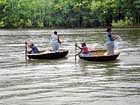Women out to fish in the Cauvery

Talk about women’s empowerment. These women spread their nets over the shimmering waters, and with oars in hand, they manoeuvre their handmade boats with grace. They go out far into the river all night, and come home with a good catch. The river is their home. Nothing can shake them, neither the gusts of wind nor the waves. With their strong hands, they hold their oars and row on.
Ask them how they manage, and they smile nonchalantly and tell us that they who were born and grew up by the Cauvery will always be guarded by the river.
We are talking about fisherwomen who live in the villages surrounding the Kannambadi backwaters.
The women of Meenakshipura are particularly famous for their fishing capabilities. These women have also formed a co-operative society, comprising 63 members. They all row across the river in unison, and earn their livelihoods with the help of the fish they catch.
The backwaters of the Krishna Raja Sagar dam is spread across 194 kilometres. The backwaters cover Pandavapura, K R Pet, K R Nagar, Hunsur, and Srirangapatna taluks and provides a means of livelihood for families of over 600 fisherwomen.
Migrated from Tamil Nadu
These families migrated to this region from Tamil Nadu when the dam was being built.
They live on the banks of the Cauvery. Typically, all their fishing activities are carried out between the months of October and February.
They take out their boats in the afternoon, and set out to fish in the river. They finish their dinner in their boats too.
Explains Marudamma, “After the nets are spread across the waters, it also becomes our responsibility to keep vigil. At 6 am, we take out our nets, which by then, are laden with fish. We then bring the catch back home, clean it, and make arrangements to sell them.”
“In the rainy season, though, we don’t have much work. There is not much fish when it rains. Also, from the last 14 years, not enough fish have been released into the KRS. That has affected out livelihoods too,” she says.
“We are fisherwomen with licences. We have photo identity cards too. Still, there are lots of unauthorised fisherfolk here,” explain some fisherwomen here.
Elaborating on their travails, Ayyamma, a fisherwoman explains, “We sometimes set out to fish with two-month-old babies in tow. Our daily bread is important for us. The money we earn in six months keeps us going for the rest of the year.”
They get a catch of about five to ten kilos of fish every day. Each kilo is sold at a price ranging between Rs 40 and 50. The net costs at least Rs 60,000, but it lasts barely three months.
Similarly, the boat also needs to be constantly spruced up, on an annual basis. Though there are problems galore, the women are not willing to give up on fishing. None of the children of these fisherwomen attend school. They spend most of their time in the boats, and are more interested in fishing than anything else.
Only one educated youngster
There is only one youngster in the whole of Meenakshipura who has managed to pass his SSLC exam. All the other children follow in their parents’ footsteps.
It is rare to find fisherwomen even in the coastal regions.
Typically, women in the coastal areas are not known to take out their boats to set sailing.
But, these women who live on the banks of the Cauvery, are setting out to the river, and building their own lives.
The Karnataka Co-operative Fisheries Corporation has decided to released two crore fish into the KRS. Local fishermen’s associations have also offered their support for the same. Also, it has been decided to provide an opportunity only for licensed fisherfolk. This has given a new ray of hope for women of the region.
(Translated by SK)
Deccan Herald is on WhatsApp Channels| Join now for Breaking News & Editor's Picks